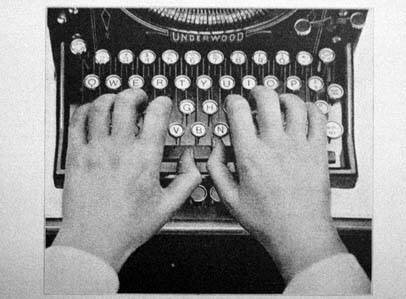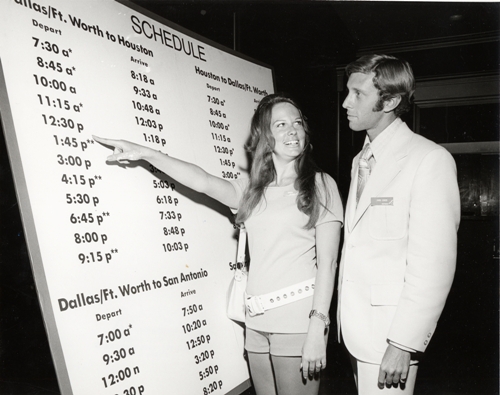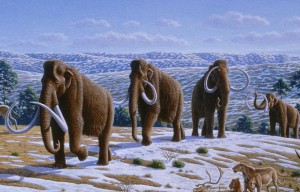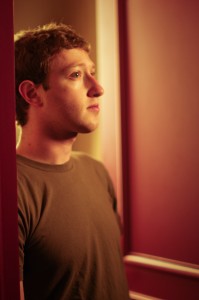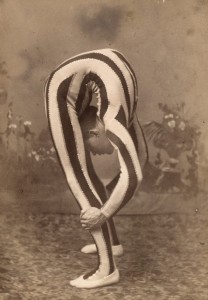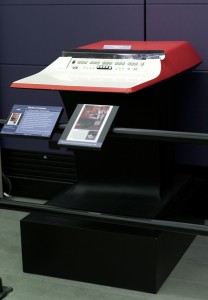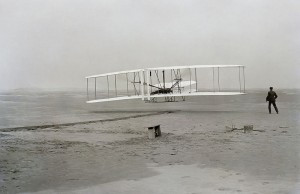A few keyphrases bringing traffic to Afflictor this week:
You are currently browsing the yearly archive for 2011.
A few keyphrases bringing traffic to Afflictor this week:
- Classic DVDs: The Man Who Fell to Earth (1976) + Umberto D. (1952).
- Old Print Articles: Rowdy Brooklyn monkey to be shot (1894) + Friedrich Nietzsche dies, gets mocked (1900) + Contortionist poisoned by his own tights (1894).
- Featured Videos: Six-year-old drivers in Arizona (1954) + Chimpanzee plays Pac-Man + Today’s kids analyze yesterday’s tech gadgets + Trailer for The Young Nurses (1973) + Syd Mead and his futuristic art + Office of the future (1969) + Southwest Airlines commercial (1972) + Britain of the future (1960s).
- Classic Photos: New Yorkers listen for news about JFK (1963) + First automobile show in New York City (1900).
- Recently Posted on NYC’s Craigslist: Mummified cat for sale + Need roadkill to feed rescued dog + Selling Butch, my monkey + Redecorating fish tank inexpensively.
- Listeria: World population by creed (1893) + Weekly wages in Brooklyn (1889).
- Facebook is more successful than impressive.
- Honey buns are coin of the realm in prisons.
- Chinese techno-city to be completed by 2020.
- China’s building the bus of the future.
- Woolly mammoths may be revived.
- Why William S. Burroughs moved to Mexico.
- The greatness of Harvey Wang: seltzer bottles and Adam Purple.
- Recent magazine covers that George Lois liked.
- California twins celebrate the century mark.
- Old Print Ad: Honeywell 316 Kitchen Computer (1969).
- The disappeared discos of Baghdad.
- The religious origins of bowling.
- This week’s Afflictor keyphrase searches.
This Southwest Airlines TV commercial was part of the company’s “Remember” campaign from 1972. A note about the early days of the so-called “love airline” and its co-founder Herb Kelleher from CBS News:
“Kelleher is legendary in the airline industry for doing things differently than the competition. Before he found himself Southwest’s pitchman, Kelleher was a lawyer retained by the airline to get it off the ground – a fight that took him all the way to the U.S. Supreme Court. It seemed the last thing Southwest’s competitors wanted to see was a low-cost upstart doing nothing but flying around Texas in and out of Dallas Love Field.
In 1971, ‘the love airline’ took off. At first, Southwest was known for sexy flight attendants in hot pants, which got it the attention it needed.
‘You can have a low-cost carrier and people still don’t fly it because they don’t know about it,’ Kelleher said. ‘And so, the schtick kind of fit in with getting known.'”
Tags: Herb Kelleher
After 5,000 years of extinction, the Woolly Mammoth may be getting a new lease on life, as Japanese scientists believe they’ll be able to clone the humongous beasts within a few years. It sounds like such a terrible idea. (Thanks Newser.) An excerpt from a Telegraph article about the experiment:
“Previous efforts in the 1990s to recover nuclei in cells from the skin and muscle tissue from mammoths found in the Siberian permafrost failed because they had been too badly damaged by the extreme cold.
But a technique pioneered in 2008 by Dr. Teruhiko Wakayama, of the Riken Centre for Developmental Biology, was successful in cloning a mouse from the cells of another mouse that had been frozen for 16 years.
Now that hurdle has been overcome, Akira Iritani, a professor at Kyoto University, is reactivating his campaign to resurrect the species that died out 5,000 years ago.
‘Now the technical problems have been overcome, all we need is a good sample of soft tissue from a frozen mammoth,’ he told The Daily Telegraph.
He intends to use Dr Wakayama’s technique to identify the nuclei of viable mammoth cells before extracting the healthy ones.
‘The success rate in the cloning of cattle was poor until recently but now stands at about 30 per cent,’ he said. ‘I think we have a reasonable chance of success and a healthy mammoth could be born in four or five years.'”
I suppose I should be losing sleep over Facebook’s questionable practices regarding privacy, but I’m not. What really bothers me about Mark Zuckerberg’s toy is how utterly prosaic a product it is. Zuckerberg hasn’t come up with anything great or original; his chief accomplishments are recognizing a niche in the market and having the brass to not sell the company to a big media conglomerate that would have bungled the whole thing. Facebook isn’t a perfect design like the iPod but a creeping mediocrity with some utility. It’s a global high school yearbook, and its success largely stems from how uninventive it is. John C. Dvorak explains further in his new PCmag.com article, “Why I Don’t Use Facebook.” (Thanks Reddit.) An excerpt:
“Which begs the question as to why anyone would use Facebook when it is essentially AOL done right? The fastest growing group on Facebook are people in their 70’s. Oldsters are flocking to Facebook the way they once did with AOL. Facebook is a simple system for the masses that do not really care about technology and do not want to learn anything new except something easy like Facebook.
Whenever someone tells me to check out something on Facebook, I recall the heyday of AOL with its keywords. ‘Go to the Internet at www.blah.com or AOL keyword: blah. This was a common comment on the nightly news or in magazines. The AOL keyword is replaced by the Facebook page name.
There is no reason for anyone with any chops online to be remotely involved with Facebook, except to peruse it for lost relatives. So, next time you log on, remember it’s really AOL with a different layout.
Welcome to the past.”
Tags: John C. Dvorak, Mark Zuckerberg
Brilliant, blustery and belligerent, Bronx-born advertising legend George Lois created some of the most iconic magazine covers ever, alongside editor Harold Hayes, for Esquire in the 1960s. They were the kind of uncluttered, political and thought-provoking images that are rarely even attempted today in a magazine world governed by a focus-group mentality. Lois has never been shy about his utter disdain for contemporary magazine covers, but in a new Vice interview, he reveals a few he’s liked. An excerpt.
“Vice: Have you seen a single cover from the past few years that you liked?
George Lois: Once in a while, and it really thrills me.
The New Yorker did two or three terrific covers over the last couple of years that really nailed what was going on. That terrific drawing of Obama and Hilary Clinton in bed together, answering the phone, was fucking good. David Remnick is a fan of mine. We had lunch once and he said, ‘Do you think I should do some photographic covers?’ I said, ‘What? Are you fucking nuts? You’re the only mag that stands out or has a chance of standing out! You don’t fill it with blurbs; you have drawings, which in many cases are whimsical and sweet. That’s terrific, but you should do a cover about something that happened last Thursday. Have somebody come up with a great idea on Friday, and then it comes out the next Monday. You’ll nail what happened!’ Then he did three or four of them, and I said, ‘Jesus Christ, somebody’s listening to me!’ But that’s about it.”
Tags: David Remnick, George Lois
Macaque monkey for sale to good home – $575 (Berry St. & 10th St)
I’m getting shipped out and have to let loose of this beautiful 8 year old male Rhesus Macaque monkey named Butch. We’ve had him for 7 years and it breaks my heart to let him go. We have all the paperwork making him a legal to own in the U.S. and he is tame and used to being around people and dogs. Trust me, you’ll be the center of attention every where you go!
Check around, this price is amazing, I need to find him a good home ASAP – by next week. Must go to a good home and I will need to see his living arrangements before the deal is final. Butch comes to work with me every day, so feel free to stop in and check him out
Tags: Butch
Range of salaries for various trades in 1889, taken from the 1890 Brooklyn Daily Eagle Almanac. All wages weekly except where otherwise noted.
- Bakers…$18-25
- Barbers…$9-13
- Bartenders…$6-20
- Brewery Employees…$15-18
- Bricklayers…$15-30
- Butchers’ Employees…$9-13.50
- Carpenters…$15-19.50
- Cart Drivers…$10-12
- Cellar Diggers…$12-15
- Cemetery Laborers…15¢ per hour
- Chewing Gum Makers…$4-21
- Cigar Makers…$9-20
- Clock Makers…$15-18
- Coffee Handlers…$10.50-12
- Firemen…$2-2.50 (per diem)
- Fur Workers…$6-8 (girls), $10-12 (men)
- Glass Workers…$16-20
- Grave Diggers…16¢ per hour
- Hatters…$15-20
- Horseshoers…$18-21
- Iron Workers…$18-21
- Leather Workers…$18.50-21
- Longshoremen…30-45¢ per hour
- Locksmiths…$18-19.50
- Lumber Handlers…$10.50-12
- Marble Cutters…$21
- Musicians…$17-30
- Painters…$16.50-18
- Steamboat Pilots…$125
- Plasterers…$24
- Plumbers…$16.50-21
- Printers…$18
- Railroad Employees…$10.50-14
- Roofers…$12-21
- Shoemakers…$6-18
- Soap Makers…$12-25
- Stair Builders…$19.50
- Stone Masons…$23
- Straw Workers…$3-12
- Tin Can Makers…$18-20
- Truck Drivers…$12-13
- Varnishers…$12-15
- Waiters…$10-13
A five-minute clip from a documentary about “visual futurist” artist Syd Mead, who, in addition to creating his own tech-friendly, optimistic work, has been a key force in the art department of many huge sci-fi films, including Blade Runner. In a 2009 interview, Mead addressed the future of our planet:
“Q: What do you think our future will look like? Can we expect something positive or negative?
Syd Mead: The future is what we try to make of it. Obviously we’re going through a earth warming period, which could be caused by our local star, the sun, or other reasons like the accumulation of carbon dioxide. But you have to remember that nature has treated this planet rather harshly several times before, take the asteroid for example that wiped out the dinosaurs.
You have to realize that over 80% of the scientists and engineers that have ever lived are alive right now. So if anything is going to be figured out we’re in a good position to do so now. I like to image a bright future, because that’s healthy. If you really believe that the world is coming to an end then it probably is – you’re helping.”
Tags: Syd Mead

A 1940s photo of the Argentine actors known as the Legrand sisters. No public domain photos available of the sisters featured in the "Times" story.
Bob Pool of the Los Angeles Times reports on Inez Harries and Venice Shaw, twin sisters in California who are celebrating their 100th birthdays this Sunday–together, of course. These women remained close and share similar lives and tastes, but even twins who are separated at birth seem to have much in common despite the different stimuli they experience. Nature is a fierce thing, even in the face of nurture. An excerpt:
“Born Jan. 15, 1911, in Pasadena to citrus ranch manager William Hesser and his wife, Anna, the twins were reared in San Fernando and later in what is now Granada Hills. The family also lived in Whittier for a time.
Harries is now a Sylmar resident and Shaw lives in Newbury Park.
Inseparable as young children, the twins dressed alike, double-dated as teenagers and worked at the same Sunkist packing house as young adults. Later, after both were married, the two couples vacationed together on camping trips to such places as Yosemite and Kings Canyon national parks.
Family photos show them dressed in identical baby clothes and in matching dresses, sewn by their mother, in elementary school and high school — their San Fernando High School senior portrait from 1929 shows them wearing identical pink polka-dot outfits.
In grade school, the pair had the same friends — at the same time. They would pick one girl and Inez would be on one side of her and Venice on the other, they recall.
‘Other kids called us ‘Twinny’ rather than make a mistake calling us the wrong name,’ Harries said.”
Tags: Anna Hesser, Inez Harries, Venice Shaw, William Hesser

"Utilizing the concept of a compact, multilayered city, the Urbanscape is a dense, compact city core where facilities are located within close proximity of each other."
The target date is 2020 for the 30-square-kilometer planned Chinese community to be known as Tianjin Eco-City. A working laboratory of the newest green technologies and eye-popping gizmos, the community will be home to 350,000 residents. An excerpt from the development’s website:
“Eco-City will make use of the latest sustainable technologies such as solar power, wind power, rainwater recycling, and wastewater treatment/desalination of sea water. In order to reduce the city’s carbon emissions, residents will be encouraged to use an advanced light rail system, and China has also pledged that 90 percent of traffic within the city will be public transport. The development also features some beautiful public green spaces.
The city will be divided into seven distinct sectors – a Lifescape, an Eco-Valley, a Solarscape, an Urbanscape, a Windscape, an Earthscape and Eco-Corridors. Surrounded by greenery, the Lifescape will consist of a series of soil-topped mounds that will counteract the towering apartment buildings of the other communities. To the north of the Lifescape, the Solarscape will act as the administrative and civic center of the Eco-City. Demonstrating the concept of a compact, multilayered city, the Urbanscape will be the core of the Eco-City, featuring stacked programs interconnected by sky-bridges at multiple levels to make efficient use of vertical space. In contrast to the Urbanscape, the Earthscape will act as a sort of suburb of the city, with stepped architecture that will maximize public green space. Last but not least, the Windscape will transform Qingtuozi, a century-old village surrounded by a small lake, into a venue for citizens to relax and recreate.”
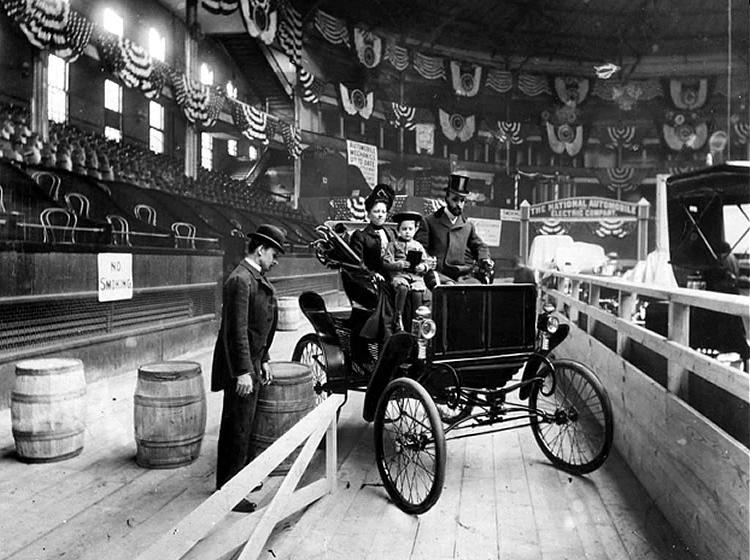
A ticket to the initial New York Auto Show in 1900 cost fifty cents, which would be more than $12 by today's standards.
The initial New York Auto Show took place in 1900 at Madison Square Garden. There had previously been joint bicycle and auto shows in the Garden (with bicycles in the starring role), but this was the first large-scale, modern car show of its kind in America. And it wasn’t all about internal combustion engines and fossil fuels. An excerpt about the event from the October 13, 1900 Brooklyn Daily Eagle:
“During the Automobile Show at Madison Square Garden, November 3 to 10, there will be contests of many kinds. The usefulness of the automobile in all kinds of going and under all conditions will be fully tested, and everybody will have an opportunity to see how the experienced chauffeur gets out of trouble. All the contests but these on Friday will be for vehicles on the show, and the programme, under the directions of the technical committee and the contests and exhibition committee of the Automobile Club of America, C.J. Field, chairman, will be as follows–
- November 3: Brake contest and obstacle contest for steam vehicles.
- November 5: Brake contest and obstacle contest for electric vehicles.
- November 6: Brake contest and obstacle contest for gasoline vehicles.
- November 9: Obstacle contest between electric cabs for hire, competition of electric delivery wagons.
- November 10: Championship competition and obstacle contest between winners in steam, electric and gasoline, championship between winners of stopping competition in steam, electric and gasoline.”
The First Post has an interesting piece about a proposed “straddling bus” in China that will ride above traffic on stilts and be able to transport 1,000 passengers at a time. An excerpt:
“The bizarre-sounding idea is the brainchild of Shenzhen Huashi Future Parking Equipment company, which has developed a ‘3D Express Coach’ that stands four metres high and resembles a moving bridge.
The bus, which is actually a light-rail train, can travel at speeds of up to 60kmph and will be able to carry more than 1,000 passengers. Not only does it reduce congestion, it also cuts down on pollution as it is powered by electricity and solar energy.
And the idea is not as far fetched as it might appear. Work on special tracks for the buses is expected to begin in the Mentougou district in Beijing later this year. But the buses don’t come cheap, each vehicle will cost $75m.”
A film rich enough to be read about a dozen different ways, Nicolas Roeg’s trippy 1976 genre picture uses an extraterrestrial tale to examine the immigrant experience, the uncomfortable marriage of art and commerce and the nature of cultural imperialism. But in a broad sense, it’s a story, much like Kafka’s “A Hunger Artist,” about the overwhelming isolation experienced by those who dream the biggest dreams and then have the fortune (and misfortune) to have their ambitions realized.
Thomas Jerome Newton (David Bowie), equal parts Howard Hughes and Nikola Tesla, is an alien from outer space who’s left his water-starved planet to secure some much-needed H2O from Earth. In America, Newton, disguised as a human, plays the role of a reclusive, obsessive British inventor, and uses money accrued from his remarkable tech inventions to try to build a spaceship that can return him with water to whence he came. In the meanwhile, he immerses himself in the free-for-all that is American culture and becomes the leading innovator on the planet. But more money means more problems, and soon Newton is whisked from his remote New Mexico desert home by some evil capitalists who want to know who and what he is.
Newton is transformed into an otherworldly guinea pig by his captors, poked and prodded by corporate medicos, who decide to X-ray the strange man’s eyes, not realizing that they will permanently solder his fake human eyes over his real ones. Once the deed is done, the inventor screams in horror: “They’re stuck. I’ll never get them off!” Newton knows that he’ll never be able to see things the same way anymore. For the immigrant, artist and industrialist, things have gone too far and he can never go home again.•
Tags: David Bowie, Nicolas Roeg
Lots of gizmos and gadgets.
A vital report from Indiana reached the offices of the Brooklyn Daily Eagle on September 1, 1894. It concerned a contortionist who had apparently been poisoned by the dye in his green tights. An excerpt:
“Anderson, Ind.—Raymond Wood, a contortionist, is lying in a precarious condition, caused by wearing green tights. He did his act at a home minstrel performance in this city last Friday and in perspiring the tights faded. The was especially the case on his right leg below the knee. He thought nothing of it and was surprised to find the member highly inflamed the next morning. It had become discolored and swollen to twice the usual size and it is now feared that amputation will be necessary, if not more serious results are caused by blood poisoning, extending over the entire system.”
Tags: Raymond Wood
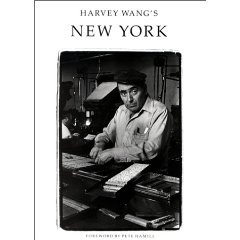
One of Wang's subjects, bowling alley mechanic Bill Newman, is someone I recall from my childhood in Queens.
Of all my favorite books about NYC, I think the one I love above all others is Harvey Wang’s New York. The 1990 book contains an introduction by Pete Hamill and just a few dozen black-and-white photos with a paragraph of text accompanying each one. And that’s all it needs.
Wang, a photographer and filmmaker, who maintains a website of his work, uses his trusty Leicas and Nikons to capture a phase of the city that had entered into obsolescence and is all but gone now: a New York that wasn’t drunk on self-awareness and star power, a place that was perhaps harder but less self-conscious.
In the book, Wang profiles New Yorkers at work in trades such as blacksmith, mannequin maker and scrap-metal collector, among others. He also interviews a seltzer bottler named George Williams. An excerpt:
“‘I go to sleep dreaming of seltzer bottles,’ says George Williams, who estimates he fills 3,000 empty glass canisters with a mixture of filtered water and carbon dioxide gas every day. He works at G & K Beer Distributors in Canarsie, Brooklyn. Kenny Gomberg, grandson of G & K founder Moe Gomberg says at the beginning seltzer was the biggest part of the business. Now it’s a novelty. George started in the business about thirty-five years ago at Cohen Seltzer Works in Boro Park, one of the dozens of bottlers in business back then. There are just a few left that fill the antique Czech-made bottles with a Barnett and Foster Syphon (sic) Filler machine that dates back to 1910. Says George, ‘The younger generation mostly goes for flavored sodas.'”
ALSO: Harvey Wang is having an exhibit of the many photographs he took of Adam Purple’s amazing Lower East Side earthwork, “The Garden of Eden,” fifteen thousand square feet of natural beauty that the artist somehow grew out of urban blight. It was sadly razed by developers in 1986. Wang’s photographs of the erstwhile oasis and its eccentric creator will be on display at the FusionArts Museum Gallery from February 2-20.
Tags: Adam Purple, Bill Newman, George Williams, Harvey Wang, Kenny Gomberg, Pete Hamill
I came across a 1954 article in Sports Illustrated about the then-booming game of bowling, which was becoming increasingly popular thanks to new machinery that automatically placed pins and returned balls. These machines were referred to in the article as “gadgets Rube Goldberg never dreamed of.” The opening of the piece explains the origins of the beer-soaked sport. An excerpt:
“The futuristic fantasy of steel and wire shown above is the pin-spotting machine developed by the American Machine & Foundry Co., a gadget which has revolutionized the bowling industry and started the pin boy on his way out after an unbroken tenure of some 17 centuries. It is a far cry indeed from the game originated around 250 A.D. by a Bavarian priest who first set up a wooden pin in the cloister of his church. He labeled the pin Heide (heathen) and called upon each parishioner to knock it down with a rounded stone. If the Kegeler (thrower) scored a hit, he was judged to be living a devout, pure life. If he missed, his soul was presumed to require cleansing at church.”
Tags: Rube Goldberg
In a Wall Street Journal article about an exhibit at the Computer History Museum, Deborah Gage recalls a pricey appliance, the Honeywell 316:
“…a short-lived experiment designed to help women store recipes, organize menus, and balance the family checkbook. As high and wide as a table, it weighed over 100 pounds, took two weeks to learn to program and was sold by Niemen Marcus for about $10,000 in 1969.”
Tags: Deborah Gage
Letters of Note reprints the telegram the Wright Brothers sent to their father, who was a Bishop of the Church of the United Brethren in Christ, in 1903, after getting their Flyer to successfully make four sustained trips. The transcript:
“176 C KA C8 33 Paid. Via Norfolk Va
Kitty Hawk N C Dec 17
7 Hawthorne St
Success four flights thursday morning all against twenty one mile wind started from Level with engine power alone average speed through air thirty one miles longest 57 seconds inform Press home Christmas.
Orevelle Wright 525P”
Tags: Milton Wright, The Wright Brothers
He sort of sucks. (Thanks Reddit.)
The way medicine used to be practiced before Obamacare ruined everything.

